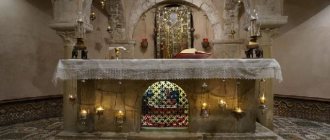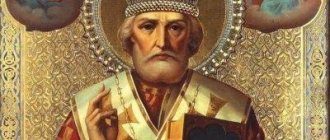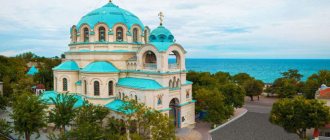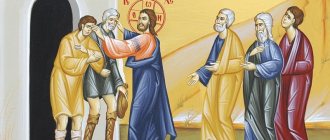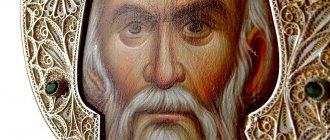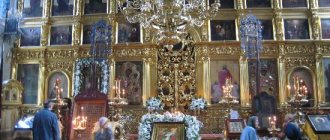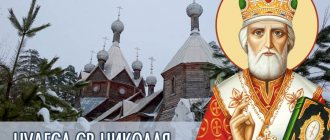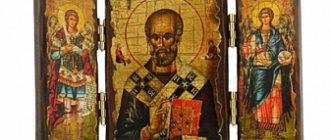Blessed Prince Alexander Nevsky
His memory is celebrated on May 23/June 5 (Rostov), August 30/September 12, November 23/December 6
Holy Prince Alexander Nevsky was born into the family of pious Russian princes Yaroslav and Feodosia. From his childhood, the Lord prepared in him a spiritual lamp, burning with faith and virtues. The holy prince never indulged in children's games and entertainment. His favorite pastime was reading sacred books and fervent prayer to God. He delighted his soul by singing church hymns, and through fasting and abstinence he strengthened and developed his bodily strength.
Having become an adult, Alexander began to reign in Veliky Novgorod. He reigned wisely and fairly and earned universal love and respect. He taught those close to him with these words: “From God we have received power over the people of God, and on the terrible day of Judgment we will have to give an account of the use of this power. When punishing the guilty, do not be cruel, balance the punishment with mercy. Don't do anything under the influence of anger, irritation or envy. Don’t forget those in need, help everyone, give alms, so that you can earn God’s mercy for yourself.”
At that time, the great invasion of the Tatars into Rus' began. They destroyed cities and villages, killing the inhabitants or taking them captive, and forcing those who remained to pay huge tribute. The Tatars did not reach Novgorod, but, taking advantage of the plight of Rus', the Germans and Swedes attacked it.
The blessed prince Alexander had very few troops, but had a lot of hope in the mercy of God and in the intercessor of Christians, the Mother of God Mary. He told his soldiers: “God is not in power, but in truth” - and, praying to the Lord and placing all his hope in Him, he won many victories over his enemies, for one of which he was named Nevsky. Thus, the blessed Prince Alexander, with God’s help, saved Rus' from German rule, and she never forgot and will never forget this great earthly feat of his.
Novgorod, although it was not captured by the Tatars, still submitted to them, because Rus' was not yet able to resist such a large army. The noble Prince Alexander was summoned to bow to the Tatar Khan.
Having communed with the Flesh and Blood of our Lord Jesus Christ and taking a blessing from the bishop, he went to the Tatar kingdom - the Horde. Before being presented to the king, he was ordered to perform the usual ungodly rituals among the Tatars, but Saint Alexander refused, saying:
“I am a Christian, and it is not appropriate for me to bow to idols. I worship the Father and the Son and the Holy Spirit, the one God, glorified in the Trinity, who created heaven, earth and everything that is in them.”
The Tatars, contrary to custom, did not kill the noble prince for such a confession and even later made him the Grand Duke.
From that time until the end of his days, Saint Alexander Nevsky gave all his strength to his homeland, trying in every possible way to ease the burden of the Tatar yoke. He ransomed the prisoners as much as he could, and for the rest he asked the Tatars for permission to open churches in the Horde itself. Wisely and mercifully ruling the Russian people, he gradually restored life to the devastated land, trying to alleviate the difficult situation of the inhabitants.
Invincible in battle, he was exhausted under the burden of the grand ducal crown and soon died, not even reaching the age of forty-five. Having received the Holy Mysteries of Christ before his death, he quietly departed to the eternal abode and gave up his pure soul to the Lord.
And one hundred and twenty years later, the body of the blessed prince Alexander Nevsky was found incorrupt.
And now he preserves the destiny entrusted to him by God - our Fatherland. And now he is close to everyone who calls on his holy name with faith, pours out his mercy and intercedes before the throne of the Almighty God. To him be honor and glory forever and ever.
Every parent knows that children need to be raised with positive examples. But, perhaps, a monotonous story about some “right person” who was kind, decent, studied diligently and always washed the dishes after himself will not cause anything but boredom in restless boys and girls.
“The Lives of the Saints” are not just instructive works about the destinies of outstanding people who lived centuries ago: warriors, hermits, queens, generals, princes and wanderers. These are always exciting stories about choices, the struggle between good and evil, exploits, heroes and true love. Especially for young readers, the Nikeya publishing house has released a large series of adapted “lives”.
Each book in the anthology is a fascinating journey into the world of the past, where history comes to life and incredible events take place. So that you can easily choose the saints you want to introduce your children to, Nicaea has collected the books in this series into thematic sets.
EDITOR'S CHOICE LABYRINTH - 5 BOOKS Orthodox saints. A large set of Dmitry of Thessalonica, the prophet Elijah, the healer Panteleimon, Joachim and Anna - these names are familiar to Christians all over the world: in golden-domed Moscow and in majestic Rome, in hospitable Greece and sunny Spain. ALREADY IN CART
ALREADY IN CART
ALREADY IN CART
ALREADY IN CART
ALREADY IN CART
1614 rub. 1131 rub.
Here are collected ten books about very different people who lived in different countries and in different eras. But they all have one thing in common - during their lives they selflessly devoted themselves to their faith and showed us an example of love, will, mercy, wisdom and nobility. Vivid illustrations and interesting stories written in lively language will introduce children to outstanding personalities and unobtrusively and without moralizing tell them about important things.
EDITOR'S CHOICE LABYRINTH - 3 BOOKS Russian saints. Large set ALREADY IN YOUR CART
ALREADY IN CART
ALREADY IN CART
984 rub. 689 rub.
The history of our country is rich in amazing people and destinies: princes, holy fools, passion-bearers, saints and patriarchs. The large and small sets “Russian Saints” include books about the most revered Russian saints, including Seraphim of Sarov, Sergius of Radonezh, Xenia of St. Petersburg, Matrona of Moscow, John of Kronstadt, Princess Olga and many others.
EDITOR'S CHOICE LABYRINTH - 2 BOOKS Russian saints. Small set ALREADY IN YOUR CART
ALREADY IN CART
706 rub. 494 rub.
EDITOR'S CHOICE LABYRINTH - 2 BOOKS For girls and more What are our girls made of? ALREADY IN CART
ALREADY IN CART
656 rub. 460 rub.
For young ladies, the Nikeya publishing house has collected five stories about the destinies of famous holy women, whose great deeds, wisdom, ability to love, console and compassion will become an excellent example for young ladies. These are stories about ancient times, beautiful queens and princesses, amazing feats and adventures.
EDITOR'S CHOICE LABYRINTH - 3 BOOKS For boys and not only These outstanding personalities are a wonderful guide for future men. ALREADY IN CART
ALREADY IN CART
ALREADY IN CART
990 rub. 694 rub.
The set “For Boys and Not Only” includes fascinating biographies of brave and courageous saints: Alexander Nevsky, St. Luke of Crimea, Dmitry of Thessalonica, Emperor Constantine the Great and Patriarch Tikhon of Moscow. The stories of these five people will introduce boys to true courage and responsibility.
EDITOR'S CHOICE LABYRINTH - 5 BOOKS Saints of the first centuries The set “Saints of the first centuries” consists of biographies of the “early” saints who lived and worked at the beginning of the history of Christianity. ALREADY IN CART
ALREADY IN CART
ALREADY IN CART
ALREADY IN CART
ALREADY IN CART
1601 rub. 1122 rub.
Believers call these people “pillars of Orthodoxy.” Five colorful books will tell the children about the apostles Peter and Paul, Basil the Great, John Chrysostom, the parents of the Virgin Mary, the righteous Joachim and Anna.
“Formation of spiritual values in children using the example of the lives of saints”
Elena Bobrova
“Formation of spiritual values in children using the example of the lives of saints”
FORMATION OF SPIRITUAL VALUES IN CHILDREN USING THE EXAMPLE OF THE LIVES OF THE SAINTS
Bobrova E. L.,
Educator,
MBDOU kindergarten No. 72 “Watercolor”
In the modern world, a small person lives and develops, surrounded by many different sources of strong influence on him, both positive and negative, which daily fall on the child’s fragile intellect and feelings, on the still emerging sphere of morality.
When starting the process of education, it is necessary, first of all, to ask yourself what its purpose is. What do we want as a final result? What kind of person to raise?
Childhood, as the holy fathers and , in particular, St. John Chrysostom , is characterized by a craving and love for holiness , which disappears over the years under the influence of various passions. And this means that if we miss childhood in our practice, then subsequently a person is, in principle, doomed to a dull existence. the lives of the saints with your children and educate them by their examples .
The Orthodox worldview and Christian values permeate the entire Russian culture, history, folk traditions, therefore, without studying the foundations of Orthodoxy, it is impossible to understand the meaning of many literary and musical works, artistic paintings, it is impossible to be a cultured and fully educated person - it is impossible to love Russia without knowing that is in the genetic memory of the people. You cannot build the future without knowing the past.
Modern children do not know well the names and life stories of saints . That is why turning to the experience of Orthodox pedagogy at the present time, when there is a search for the spiritual revival of Russia , is especially relevant, since society and the state are in dire need of educational models.
The purpose of pedagogical work is:
• introducing children to the origins of Orthodox culture;
• formation of a constructive attitude towards the world, people and oneself.
To achieve this goal, the following tasks were set the spiritual and moral education of children
• to form a holistic spiritual , moral and social-personal development of the child based on familiarization with the traditions of Orthodox spiritual culture ;
• promote the formation in children of initial ideas about the spiritual world , the lives of saints , and introduce basic religious concepts;
• to cultivate in children a respectful , merciful, attentive attitude towards relatives, skills of benevolent and virtuous behavior .
The work is based on the program “The World is a Beautiful Creation”
- Ph.D.
senior researcher at the laboratory of the Russian school of KSU Gladkikh Lyubov Petrovna, Archimandrite Zinovy (A. A. Korzinkin, Vladimir Mikhailovich Menshikov. The content of the program is based on scientific theories about the unity of the spiritual and material existence of the world and man and is aimed at the spiritual and moral education of the child.
The main line event-substantive work on the formation of spiritual values is the Orthodox church calendar, in accordance with which the upbringing and education of children in the preschool group is structured.
When organizing direct educational activities, the individual characteristics of children and it must be remembered that the level of moral and spiritual development is different for everyone - this is due to the conditions of upbringing and the lifestyle of his family.
With all the attention to the age of children , the lives of saints cannot be simplified , distorted, or reduced to a fairy tale.
Due to the fact that in preschoolers involuntary attention predominates, and their perception is based primarily on emotions, I use in my work those events from the lives of saints that may be most interesting to children and will cause an emotional reaction in them. Children enjoy listening to stories about the childhood of saints . So, using the example of the life of Sergius of Radonezh, I teach children patience , diligence, obedience, love for parents ( for example , when parents ask him to stay at home and care for them in old age instead of living in a monastery). You can teach love for animals, because for the saint turned out to be stronger than fear, and this is how friend Misha appeared, to whom he gave the last piece. You can teach hard work, because even after becoming abbot, the monk remained the same as he was - quiet, meek, hard-working...
To develop verbal-logical thinking, it is necessary to ask questions to establish logical connections between events and actions. To do this, you can ask, for example, the following questions : why did the person do this? What could this lead to?
The teacher’s sincere approach to the material presented is important. If he shares with the guys what hurt him personally, then the story will only benefit. Children are sensitive to truth and lies. And if your enthusiasm is ostentatious, then the result of your work will be reduced to zero. Thus, the process of forming spiritual values based on the examples of saints becomes two-way: relevant for both the child and the teacher. The more the teacher himself succeeds in spiritual life , the more his pupils are immersed in it.
In my work I widely use visual aids (various reproductions, icons)
;
it greatly facilitates the process of spiritual and moral education . While reading stories, you can show children content that is difficult to convey verbally, for example , a reproduction of the icon the Blessed Virgin Mary
into the Temple ” , scenes from
the lives of saints . This allows the child not only to imagine, but also to see with his own eyes the character being depicted, which helps children form initial ideas about the spiritual world .
Walks, excursions and joint activities with children were identified as a separate area of work, defining them as a preliminary form of work . For example , when studying the topic “Celebration of the Intercession of the Blessed Virgin Mary "
told the children about the holiday, that
the Most Holy Theotokos is the Intercessor for the whole world, that the event took place far away in a warm country, where once upon a time the Most Holy Theotokos . She invited the children to listen to Viktor Afanasyev’s poem “Heavenly Pilgrims”
and think about why the poet compares cranes with pilgrims.
The children told that Jesus Christ and the Blessed Virgin Mary lived in warm countries where migratory birds fly in the fall.
The children answered without difficulty, since preliminary work was carried out on a walk, where they observed changes in nature: the autumn colors of trees, the flight of birds, listened to a story about warm countries, poems about autumn, collected colorful leaves - all this served as rich material for future direct educational activities and helped in the development of the child’s creative personality. Most children who go to kindergarten grow up in houses where there are no icons, so introducing preschoolers to the art of icons is simply necessary, because the icon speaks not only about what is seen, but also about what is inside us, connecting the past and the present.
When introducing children to the icon , stories are read about Christian holidays: Christmas, Epiphany, Easter, and the traditions of celebrating them in Russia. Such work helps children become acquainted with the fundamentals of the spiritual and moral traditions of the Russian people.
So, using the example of the life of St. George the Victorious , the patron saint of Orthodox warriors, in whose name the main word is victory, she told the children that St. George was a courageous warrior. He stood up for Christians and himself suffered a lot, which he endured heroically with prayer on his lips. Among the heroes of Russia there was a man who bore the name of a saint . Where Georgy Konstantinovich Zhukov commanded the front, the army always defeated the Nazis. It is not for nothing that his patron is Saint George the Victorious .
It wasn't thunder that thundered in the silence
The gray clouds did not move
That's George on a white horse
Again he stood up for Russia...
Such work forms in children an idea of heroism, develops an emotionally positive, effective attitude towards soldiers, which is expressed in the desire to imitate them in agility, speed, courage, in the desire to be like them, and fosters patriotic feelings for their Motherland.
During the work on the topic “ Formation of spiritual values in children using the example of the lives of saints ,” several thematic entertainments and theatrical performances were held: “City Day. Alexander Nevsky - the heavenly patron of Stary Oskol"
,
“Pokrovskaya Fair”
,
“Mother’s Day”
,
“Light of the Star of Bethlehem”
,
“Baptism of the Lord”
.
These events allow children to form the habit of preparing for and celebrating Orthodox calendar and civil holidays with their families, and to strive to understand their true meaning in life.
Raising the younger generation using the example of the holy saints of God is a kind of guiding star. They are for us an example of love for man and in man. With their lives the saints showed what spiritual beauty man is called and capable of. In addition, in the lives we find a deeply spiritual explanation of the most important issue - faith in Christ. I would like to end with a quote from St. John Chrysostom : “Monuments of saints are served not only by graves, tombs... pillars and inscriptions, but also by good deeds, zeal for the faith and a clear conscience before God.”
The Life of St. Nicholas the Wonderworker retold for children
20.12.2018
- Review author: Soyuz TV channel
Alexander Tkachenko. The Life of St. Nicholas the Wonderworker retold for children
“Among the great multitude of Christian saints, there is one saint of God, who at all times was especially revered by believers. This is St. Nicholas the Wonderworker. Icons with his image can be seen in any Orthodox church in the most honorable places. A thin old man looks at us from the icon with a kind and slightly sad look. As if asking: “Well, my dears, what other trouble have you found yourself in, what trouble do you need to rescue you from?” Sailors, travelers, fishermen, drivers, poor people consider him their patron... This is such a strange company. And all because Saint Nicholas helps everyone who turns to him for help. True, Saint Nicholas lived a long time ago, 1600 years ago, but people still remember and revere him. What was he doing that was so special?” Alexander Borisovich Tkachenko told our young readers about this in his book, published by Nikea Publishing House. It is called “The Life of St. Nicholas the Wonderworker in a retelling for children.” ***
As noted on the website of the Nicaea publishing house, “The Lives of the Saints is an old and very popular genre. These are artistically conveyed historical testimonies about people of holy life. We, say the publishers, have created a large series of unique lives of saints, retold by authoritative authors especially for modern children, in understandable language and with interesting illustrations. Our series contains the lives of holy women and holy men, princes and commoners, warriors and doctors. This is a whole palette of amazing life stories, events and God's Providence. Choose from over 35 books and build a library! Each book is worth two evenings of reading aloud. You can read together before bed, you can arrange home readings on the weekend - everyone reads their favorite book, and then the family discusses the stories they read together.”
Take, for example, stories from the life of St. Nicholas, which are told on the pages of this book by the famous publicist, regular author of the Thomas magazine, father of four children, Alexander Tkachenko. And first of all, he invites our young readers to think about this question: “How should you live so that even after sixteen centuries your image would be lovingly kept by millions of people around the world?” This author is speaking, of course, about Saint Nicholas, and continues: “But there seemed to be nothing special about him, he was an ordinary person, just like you and me. He just always acted differently from what everyone else would have done in his place. Saint is what it means: not like everyone else. And here are a few stories from his ordinary-extraordinary life.
A long time ago, on the shores of the Mediterranean Sea stood the city of Patara. There was a large port where ships loaded with spices, grain, fabrics and all sorts of overseas wonders sailed. At the port, tanned longshoremen carried bales of goods ashore and loaded them onto horses and camels. Meanwhile, the sailors were repairing their ships, mending sails torn by the hurricane and preparing for a new voyage. In this city of sailors, caravan workers and shipwrights lived one young man. His name was Nikolai. He was a priest and often communicated with a variety of people who came to his temple for advice and help. Despite his youth, Nikolai was very wise and attentive to the grief of others. He was ready to help everyone, tried to console everyone.
But one day Nikolai received an inheritance and became very rich. What do people usually do when they get rich? Well, of course they build themselves a palace of white marble! With peacocks, fountains, a peach garden and a pool with goldfish swimming. Guards are placed at the entrance so that no one interferes with the owner’s enjoyment of the happiness that has befallen him. That's probably what a lot of people would do. But Nikolai disposed of his wealth in a completely different way, not like everyone else. The young priest knew well the troubles and sorrows of his parishioners. And... he began to distribute the money he inherited to those who needed it. True, he also did this in an unusual way.” For example, he threw gold out the window and ran away. Why did he do this? It’s just that, as the author notes, Saint Nicholas really didn’t want anyone to know about his help. After all, if you do a good deed for show, it turns out that it is not so good after all.
But no matter how hidden the young priest was, fame soon overtook him anyway. “After all, he fed the hungry, bought clothes for the poor, redeemed debtors from slavery, and very quickly spent all his money on this, to the last penny. And word spread throughout the city about what a kind and selfless person he was. Here he should rejoice in such glory, says the author. - But Nikolai acted unusually again. Having learned that in Patara they began to venerate him as a saint, he boarded a ship and sailed away from his hometown forever. Having crossed the sea, it must also be said not without adventure, the saint stopped in the city of Myra. And before I tell you what happened to priest Nicholas about this city, I will note that during the sea voyage two miracles occurred, which occurred through the prayers of the Pleasant of God. Which ones exactly, young readers will learn from this book.
Well, the author talks about the new shelter of the future saint as follows: “In any big city there are many beggars and vagabonds. There were also plenty of them in the capital of the country, Lycia, the glorious city of Myra. As beggars should, they sat in a noisy crowd at the entrance to the church or wandered around the city market, begging for alms. In the evening, with the money they collected, they bought themselves bread, cheese, and cheap wine at a port tavern and had a small feast, which sometimes ended in scandals and fights. And in the morning, with fresh bruises and abrasions, they went to beg again - some to the market, some to the church, some to the port... But there was one among the city beggars who behaved differently from the rest. He was strange, this beggar. Never begged. He did not participate in the drunken parties of the poor brethren. And his clothes were always clean, although shabby.
No one knew where he came from in the Worlds, what his name was or who he was. But everyone knew that every day at first light he came to the main temple of the city, stood in the farthest corner and prayed almost until late at night. Compassionate women who worked in the temple sometimes fed him. But he ate very little - a piece of bread, a bowl of porridge, a couple of olives... And this was for the whole day! Thin, silent, but he stood at church services, and after that he helped women wash the floors in the temple and clean the candlesticks. So, he spent the whole day in prayer and small household chores, and left in the evening. No one knew where the strange beggar spent the night either. But every morning he came to the temple before everyone else to pray alone before the start of the morning service.
And then one day,” the author narrates, “Archbishop John, the most important priest of the Lycian country, died in Myra. Bishops and priests from all over Lycia came to the city to elect the most worthy to the vacated throne. They thought and thought, decided and decided, but they just couldn’t come to an agreement. There are many worthy people, but you only need to choose one. What to do here? They began to pray that God would indicate who should become the head of all the Lycian priests. And so, during prayer, God commanded the eldest of the bishops: “Go to the doors of the temple at night and see who will be the first to come to church in the morning. This person is My chosen one. His name is Nikolai". He told his brothers about this, and everyone decided: so be it. That same night, the bishop who received the command came to the church doors and began to wait. It was already beginning to get light when steps were heard and... a beggar appeared on the porch of the temple. The same one who came to church every day before everyone else to pray. The bishop stopped him and asked him to give his name. The beggar was silent. The bishop asked him the same thing again. And then the beggar quietly answered: “My name is Nikolai, I am a slave of your shrine, master.” You probably already guessed that our old friend, a priest from the city of Patara, was an unusual beggar. So Nicholas became Archbishop of Myra. The author of this book talks about this in more detail.
As the publishers note, “every day the Orthodox Church remembers the memory of some saint. There are thousands and thousands of them in the history of the Church. These were ordinary people who through their lives became friends of God. They are like beacons for us; we can orient ourselves by their light. Our child grows up and follows the guidelines that surround him. It is very good when, from childhood, he sees examples of good deeds and motives. And personal example is the best thing that can happen in education. The heroes of the fictional world will soon become just a fairy tale, and it will be extremely important for the child to have real-life reference points. The lives of saints are the life stories of real people.” A variety of authors talk about them in the series “Lives of Saints Retold for Children”
SOYUZ TV channel
